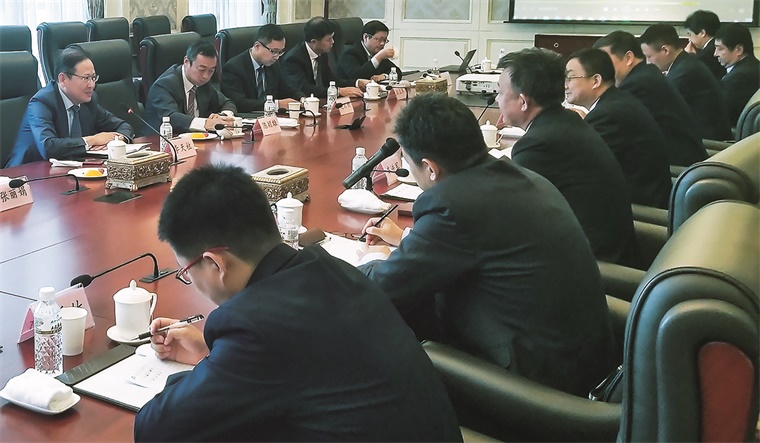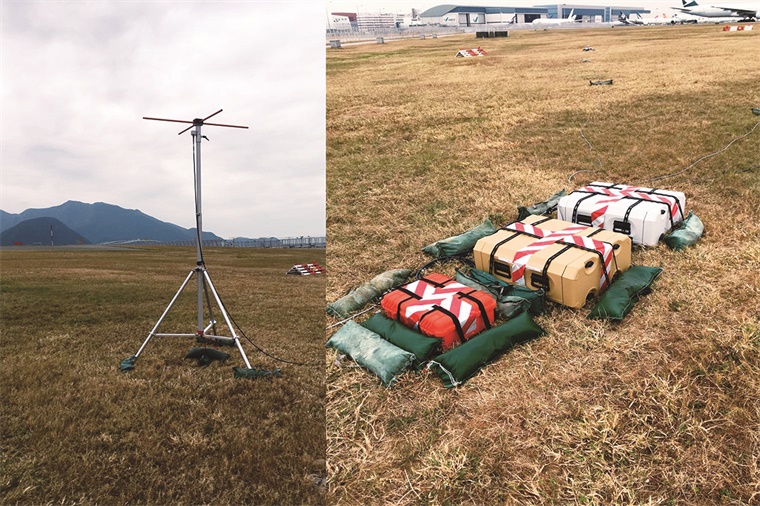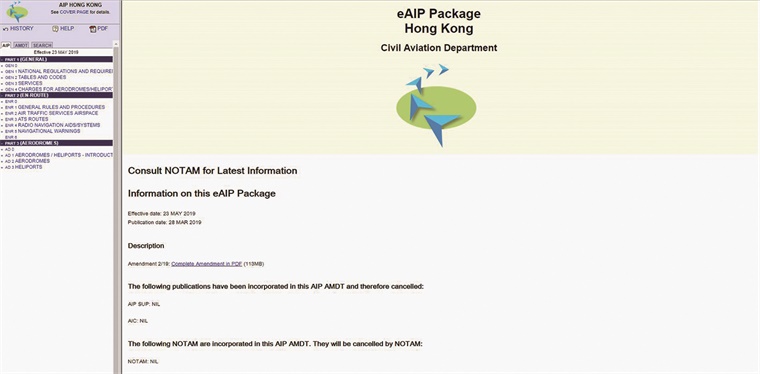The Air Traffic Management Division (ATMD) is responsible for the provision of air navigation services to civil aircraft operating within the Hong Kong Flight Information Region (HKFIR). The services include air traffic services; communications, navigation and surveillance; and search and rescue coordination. With the mission of providing reliable and sustainable air navigation services and maintaining efficient and orderly air traffic operations within the HKFIR, ATMD is also responsible for the training of air traffic control (ATC) personnel, provision of aeronautical telecommunication services and design of ATC procedures.
2018 was a very challenging year for ATMD. On one hand, initiatives were continued to be implemented to enhance our handling capacity in order to meet the ever-increasing demand for air traffic. On the other hand, extreme natural meteorological phenomenon had almost stretched our system to the limit from time to time. For example, during the passage of Super Typhoon Mangkhut in September 2018, over 1 000 flights at the Hong Kong International Airport (HKIA) as well as over 700 overfly traffic were affected. With concerted effort made by ATMD, air traffic order was successfully restored within 24 hours after the hurricane signal no. 10 was lowered.
Stepping into 2019, ATMD continues to face the challenge posed by the strong demand for air traffic. Apart from the steady growth of air traffic, there are huge volumes of flights during festive holidays. An all-time high daily air traffic movement record of 2 467 was set on 2 February 2019 during the Lunar New Year period. Such achievement manifests the competence of the air traffic control staff and the effectiveness of the air traffic management system.
Air Traffic Operations
During the financial year, there were a total of 430 022 aircraft movements at HKIA handled by ATMD. In addition, the division had handled 380 795 overflights transiting the HKFIR (65 647 of which were flights into and out of the Macao International Airport). Year-over-year, the aircraft movements at HKIA and the number of overflights handled by ATMD had increased by 1.17% and 12.07% respectively.
Runway Capacity
The handling capacity of the two runways at HKIA was maintained at a maximum of 68 movements per hour within the year.
Examinations and Revalidations of Air Traffic Control Officer Ratings
To ensure that required performance and safety standards could be maintained, the Training and Safety Section of ATMD carried out regular practical examinations on Air Traffic Control Officers (ATCOs) according to the established mechanism. In the year, 188 practical examinations were conducted in the three ATC streams – Aerodrome Control, Approach Control and Area Control. In addition, ATMD also issued Assistant Controller Certificates, ATC Meteorological Reporter Certificates, On-the-job Instructor Certificates and Flow Control Certificates to officers who had attained these qualifications.
Recruitment and Training of ATC Staff
Recruitment and Training of Student Air Traffic Control Officers (SATCOs)
The recruitment and training of ATC staff have to be carefully planned and managed to meet anticipated air traffic growth and manpower needs. A total of 19 SATCOs and nine ATCO IIIs have reported duty in batches in 2018.
A recruitment exercise was also launched in 2018-19 with a target to recruit 45 SATCOs in financial year 2019-20. As qualified ATCOs are not readily available in the local job market, individuals usually join this profession at the entry level as SATCOs. After receiving specialised training, they progress from SATCO to ATCO.
During the recruitment of SATCOs, eligible candidates go through different stages of stringent assessments. These include aptitude tests, interviews, critical thinking appraisal, occupational personality questionnaire and Assessment Centre's in-depth job related assessment. These assessments aim at identifying the suitable candidates with necessary English proficiency, cognitive power and personality traits.
The training programme for SATCOs is carefully designed and arranged to meet the established performance benchmarks. It comprises training modules at different stages and adequate consolidation is allowed before advancing to the next stage. Each training module includes classroom lectures, practical training in the ATC Radar Simulator or Aerodrome Simulator, and on-the-job training at operational positions. After passing the validation check, the officer is allowed to carry out operational duties independently. The training of a SATCO to become a fully qualified controller at the rank of ATCO II normally takes around six years.
As part of the professional training, SATCOs attend basic ATC courses and flying training which are conducted by an approved training organisation. The scope of this training spans a wide range of aviation topics including ATC procedures, meteorology, radar operations and principles of flight. The aim of this training is to broaden their exposure to various aspects of ATC operations.
As at 31 March 2019, there were 302 ATCO and 131 Air Traffic Flight Services Officer (ATFSO) (supporting staff to ATCOs) established posts.
ATC Training for Other Ranks of ATCO staff
The provision of professional ATC training to staff is one of the major tasks of ATMD. Numbers of training courses and on-the-job training activities for ATC personnel were conducted throughout the year. To cope with the fast-growing air traffic within the Asia Pacific Region, more robust training activities will be anticipated in the coming years.
Over the year, 12 professional ATC training courses were conducted, leading to the issuance of 59 ATC ratings and the attainment of various professional ATC qualifications. In November 2018, Aerodrome Control Refresher training was arranged for 109 rated aerodrome controllers. The Refresher training aims to provide periodic opportunities for rated controllers to refresh on the operating procedures in relation to unusual occurrences and also ensure controllers' competency in response to unusual circumstances and aircraft emergencies.
Apart from the above, senior ATCOs were selected to attend search and rescue course, operations of modern aircraft, aircraft incident investigation and flight procedures design, etc, to broaden their horizons and enable them to undertake more specialised duties as well as management and supervisory responsibilities.
ATC/Flight Procedures
ATS Interfacility Data Communication (AIDC)
Hong Kong ATC Centre has implemented AIDC operation with Guangzhou ATC Centre in May 2018 to facilitate the automatic exchange of pertinent flight data. It replaced the manual means of coordination by voice and hence improved the operational and processing efficiency and accuracy of flight data pertinent to flight operation between Hong Kong and Guangzhou ATC Centres. It is the third ATC centre, after Sanya and Taipei ATC centres, with which Hong Kong ATC Centre had implemented AIDC operation. In addition, Hong Kong ATC Centre has also commenced an operational trial of AIDC operation with Manila ATC Centre in March 2019. Subject to a satisfactory result, it is expected to be implemented in the near future.
Support to ICAO Asia-Pacific Flight Procedure Programme (FPP)
FPP, funded by the active participating states/administrations in the Asia Pacific region, has been established since 2010 with the objective of assisting states to develop their own capabilities in instrument flight procedure (IFP) design and to accelerate the implementation of Performance-based Navigation (PBN). This is achieved by providing training courses and workshops, on-the-job training, assistance with quality assurance and procedure design processes, consultation services and access to IFP-related automation solutions. The Hong Kong Special Administrative Region, as one of the active participating members since the establishment of FPP, has been contributing by providing expertise and financial support to FPP.
In collaboration with the Hong Kong International Aviation Academy (HKIAA), FPP organised the Procedure Design Refresher Course in Hong Kong during 21-25 May 2018 which was delivered by experts from the CAD as guest instructors. This was the first time that a FPP training course was conducted outside Beijing. A total of 19 participants from eight different states including Cambodia, Indonesia, Laos, Myanmar, the Philippines, the Republic of Korea, Singapore and Vietnam attended the course. The successful course demonstrated the CAD's continued commitment in supporting the development of sustainable capability in IFP and implementation of PBN in the Asia Pacific region, and fostering Hong Kong as an international aviation training hub through HKIAA.
Use of Ground Based Augmentation System (GBAS) in support of precision approach
The CAD has been keeping in view the latest technology and is exploring the feasibility of applying the GBAS Landing System (GLS) to the Three-Runway System of Hong Kong International Airport (HKIA) in the future. Utilizing GBAS to enhance the accuracy of the satellite signal, GLS enables aircraft to rely on satellite navigation for precision approach and serves as an alternative to conventional Instrument Landing System (ILS).
Flight trial activities, during which the landing system was inspected and four GLS procedures developed by the CAD were validated, took place at HKIA between late November and early December 2018 to verify the effectiveness of the GLS. The objectives of the trial were to explore the flexibility of flight procedure design allowed by GLS, in support of advanced operations such as shorter and steeper approaches; to assess signal performance; and to evaluate the feasibility of its application in obstacle-rich environment in Hong Kong.
The flight trials were successfully completed with satisfactory results and positive feedback from pilots. It marked a milestone for the future deployment of GLS flight procedures at HKIA.
Air Traffic Management Plan for the Pearl River Delta (PRD) Region
The CAD has been maintaining close liaison with the Civil Aviation Administration of China (CAAC) and the Civil Aviation Authority of Macao (AACM) through the Tripartite Working Group (TWG) to discuss the phased implementation of enhancement measures as stipulated in the PRD Region Air Traffic Management Planning and Implementation Plan (the Plan) with the aim to raise operational efficiency.
With an objective to improve the efficiency of coordination and message exchange between ATC units concerned, an Air Traffic Flow Management (ATFM) direct communication mechanism has been established since March 2017. Since its implementation, flight punctuality for HKIA flights departing for or overflying the Mainland showed marked improvement in the year. The CAD will continue to work with the CAAC to monitor the situation and take necessary measures to mitigate the impact of ATFM on flights with the objective to gradually enhance operational efficiency of flights.
To support the continuous development of all the major airports in the PRD region, including the construction of the Three-Runway System (3RS) at HKIA and the expansion of other airports, flight procedure and airspace design specialists and other technical experts from the CAD, the CAAC and the AACM have gathered together and initiated the airspace evaluation project on Guangdong-Hong Kong-Macao Greater Bay Area (Greater Bay Area) airspace using advanced Fast Time Simulation (FTS) software. The project includes the construction of a model based on the current airspace operation and routine ATC handling practices, as well as a model based on the operation in the future. The software would conduct computerised simulation of airspace operation in the region with high authenticity, and provide data and technical support to the expert team to design a safe and efficient airspace.
Looking ahead, the CAD will continue to follow up the work plan with the CAAC and the AACM in respect of airspace optimisation, airspace capacity enhancement, operational efficiency and improvement in air traffic flow management in accordance with the framework of the Plan. These initiatives would help achieve the ultimate target runway capacity of 102 air traffic movements per hour under the 3RS operation at HKIA, accomplish greater synergy in the Greater Bay Area airspace and create an airport economic belt with international influence.

The Director-General of the Air Traffic Management Bureau of the CAAC, Mr Che Jinjun; the Director-General of Civil Aviation (DGCA), Mr Simon Li; and the President of AACM, Mr Chan Weng-hong, attended the Pearl River Delta Region Air Traffic Management Planning and Implementation Tripartite Working Group high-level meeting in Harbin in September 2018.
Aeronautical Information Management Centre (AIMC)
AIMC is responsible for the provision of aeronautical information service to the aviation community and processing of flight plans for flights departing from HKIA. In the year, AIMC handled 851 886 Notices to Airmen and 239 597 flight plans, representing a year-on-year increase of 8.8% and 1.1% respectively.
In line with the International Civil Aviation Organization's (ICAO) initiative to transition a more digitised aeronautical information management, the CAD has committed to the transition to electronic publication of aeronautical information and discontinued the issuance of hard copies of Aeronautical Information Products (including Aeronautical Information Publication (AIP), AIP Supplement and Aeronautical Information Circular) of Hong Kong in the year. Digital data-driven Electronic Aeronautical Information Publication (eAIP) was launched in March 2019. The eAIP brings about enhanced user experience by presenting aeronautical information in Hyper Text Markup Language (HTML) format in addition to PDF format, which provides better accessibility for users using common web browser, and an improved interface which offers easier navigation and more advanced search functionality.
Telecommunications Services
Being one of the major aviation communication hubs and also a Regional Operational Meteorological Centre in the Asia Pacific region, the Aeronautical Network Center (ANC) continues to provide reliable, high quality and efficient telecommunication services for the exchange of air traffic messages and operational meteorological messages to support provision of air navigation services. In addition, ANC offers 24-hour aeronautical broadcasting service to aircraft in flight for acquiring latest weather information necessary for flight operation.
During the last year, the total number of messages handled by the Air Traffic Message Handling System (AMHS) was recorded at 78 640 572, representing a significant increase of 15%. On aeronautical broadcasting service, the number of operational meteorological messages broadcasted to aircraft in flight was 323 064.
With successful implementation of voice communications of Inter-Area Speech Circuit (IASC) on Common Aeronautical Virtual Private Network (CRV) in August 2018, Hong Kong continues to participate actively in the data communication circuit connectivity test and interoperability test with Manila on CRV in early 2019. Upon completion of pre-operational trial, operational use of Hong Kong-Manila AMHS/CRV circuit will be officially declared in due course.
Safety Management System (SMS)
ATMD continued putting in substantial efforts to enhance the overall aeronautical safety performance through effective implementation of its SMS. These include safety risk assessments and risk mitigation measures to be carried out before any significant changes to air traffic management equipment, procedures or systems that may affect operations are introduced. ATMD will continue applying the safety risk management principles in our various air traffic enhancement projects related to the 3RS project at HKIA, to ensure the identified risks are mitigated properly.
Besides, ATMD monitors the safety performance on a continuous basis under the SMS requirements. Quarterly summaries on safety performance compiled by ATMD had been reviewed by the Air Traffic Management Standards Office, which is the regulatory office of air traffic management related matters independent of ATMD. To ensure continuous improvement in safety, three internal audits were conducted in the year on different key functional areas of ATMD.
In terms of safety promotion, ATMD maintained its efforts to provide ATC staff with SMS training and to promote safety culture. Relevant safety information, together with extracts from local or international safety journals, are published on a regular basis to raise the safety awareness of staff.
Overseas Aeronautical Meetings and Conferences
ATMD is one of the leading air navigations services providers (ANSP) which has remarkable contributions in enhancing air navigation services in the Asia Pacific region. To ensure continuous and close collaboration with other ANSPs in the region and seamless integration of important air navigation services upgrades in the aviation industry, ATMD actively participated in regional and international meetings, seminars and conferences organised by ICAO, Civil Air Navigation Services Organisation (CANSO) and other civil aviation authorities within the region.








